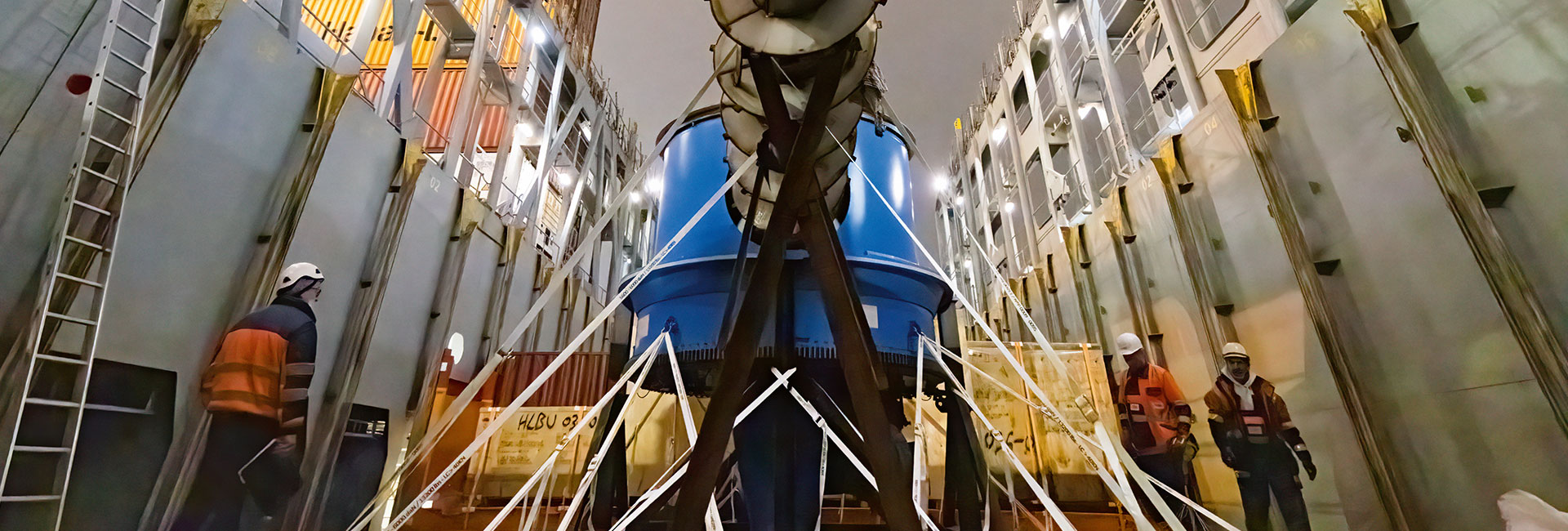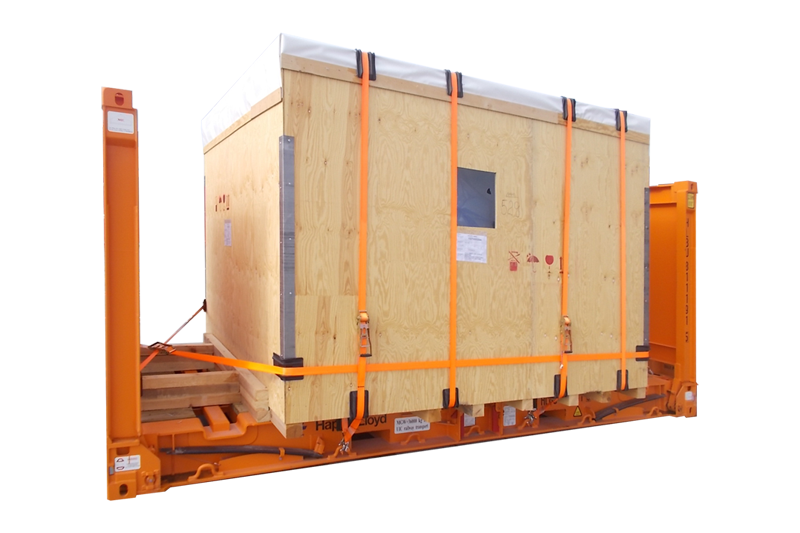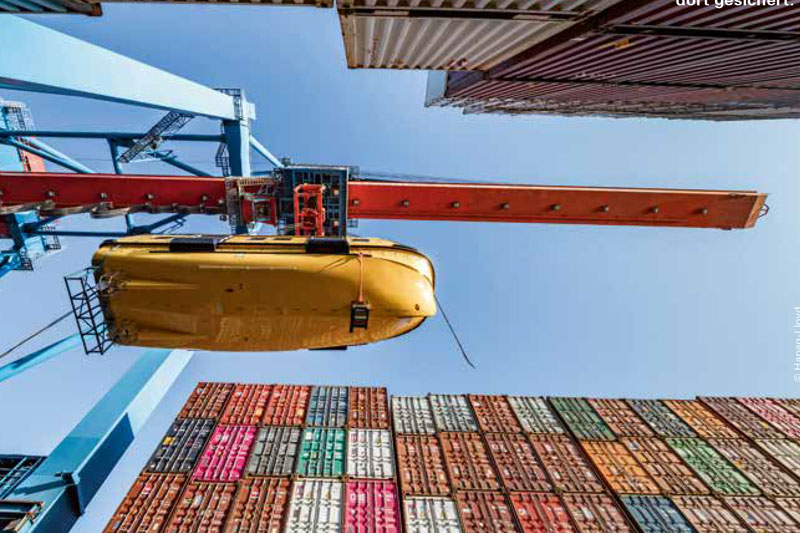Hapag-Lloyd AG
Hapag-Lloyd is one of the world's leading liner shipping companies and sets standards in customer service, e-business and productivity. Headquartered in…

On board out on the high seas, everybody needs to rely on cargo safety. The number of containers in the industry that go overboard annually may be only a matter of millionths of the total transported. Yet even losses of single boxes can inflict great damage – if hazardous goods are involved and harm the environment. To secure cargo optimally, container shipping companies, their customers and packers turn to the CTU – Code of Practice for Packing of Cargo Transport Units. The official guidance from the IMO – International Maritime Organization provides clear and simple guidance. This covers both fixing the container to the ship and on other hand, securing the cargo inside the container.
Through corner castings on the containers, these twistlocks attach them to the vessel and to one another. Lashing rods also fix the vertically stacked containers to the ship. To enable them to be separately stowed or unloaded, container stacks are no longer diagonally linked. In heavy seas, this freedom gives them improved elasticity.
The stability of the vessel must also be taken into account. A containership’s complex safety systems are measured using empirical formulae from the classification societies. Longitudinal, diagonal and vertical stresses are also taken into account. Every link in the safety chain is crucial. Yet safety in transport already starts away from the containership, in port logistics and wherever the boxes are stuffed.
Secure loading of special cargo, especially, requires consultation among all those involved. In the Port of Hamburg, for example, Hapag-Lloyd works closely with HHLA to heave heavy cargo like railway construction machines on to a containership. For a start, these have to be delivered to a special pier – see photo. “Where load safety is concerned, the level of quality in the Port of Hamburg compared to other ports worldwide is among the highest – and a very fine reference,” stresses David Piel, Senior Manager Special Cargo for Hapag-Lloyd. “When I have to send special cargo to China or Asia, I am happy to share photos from Hamburg with our teams on the spot to show them the best way of securing cargo.”
"The level of quality in
the Port of Hamburg
compared to other
ports worldwide is
among the highest"
Over ten year ago, Hapag-Lloyd was already aiming to make securing of cargo, and especially the container floor, sustainably better: More stable, requiring fewer repairs, and recyclable. The company therefore developed a steel floor. Initially, this was used for special cargoes and hazardous goods. “Details are often decisive for securing cargo,” says David Piel. “One crucial aspect is that cargo must be secured irrespective of the floor material. Nowadays though it is somewhat unlikely that on opening a container door, you’d still find a wooden floor.” All sorts of different flooring materials such as bamboo, plastic, OSB or steel in fact, can be used. Today’s stability targets mean increased use of steel. Environmental protection has become more important. One question comes up frequently: How sustainable are the materials used? A box with a steel floor that will one day be scrap can be recycled one hundred percent. One with a wooden floor is different in that it contains glue. A steel-floor container is suitable for cargoes of all types. They contain no chemical additives and last longer than boxes with wooden or bamboo floors. In 2013 Hapag-Lloyd included them in their permanent repertoire – initially mainly in the segment of 20-ft standard/special containers. Use of wooden beams plus lashing belts is the best method of keeping cargo in its place inside the container. Anti- slip material enhances friction and is used in containers with steel floors.

The Hapag-Lloyd fleet includes ships with a capacity of 1.8 million TEU and containers offering three million TEU. As one of eight topics, last year Hapag-Lloyd firmly anchored cargo safety or ‘Transport safety’ in its extended sustainability strategy. The aim is to transport 100 percent of containers safely to their destinations. Among its targeted sustainability measures, Hapag-Lloyd aims to further increase transparency about lost containers and damaged cargo. By 2023 Hapag-Lloyd will equip its entire container fleet with real-time tracking. Monitoring devices will transmit data on every container, also monitoring any sudden shaking up of the container. Digitalization is making container shipping not simply more efficient, but also safer. To sharpen up awareness of holistic cargo security, Hapag-Lloyd is supporting such flagship projects as the World Shipping Council’s ‘Container Lost at Sea’ working group and the industry-wide MARIN survey.
“Numerous heavier point-loads can be loaded per running metre. This makes the steel-floor particularly interesting for such heavy loads as machinery,” explains David Piel. For comparison: A 20-ft wooden floor can take 4.6 tons per metre, the same box with a steel floor, 7.6 tons. The difference is still greater with a 40-ft container, where a wooden floor can tolerate three tons per metre, a steel one, twice as much. “In addition, there are more lashing points than with the wood-bamboo hybrid version, so that lashing cargo can be done efficiently.” In addition, steel-floor containers can be cleaned so that, without any residues from previous loads, they can be stuffed odour-neutral with fresh cargoes These can include perishable foodstuffs, or clothing. Steel-floor containers are therefore in demand from customers in the coffee trade, among others. “Unlike the wooden floor, a steel one absorbs no odours or liquids,” explains David Piel. “With the slightly ribbed profile, the cargo is not wettened by escaped liquids or condensation.” Steel floors are therefore in growing use for standard containers. For special-cargo and hazardous-goods shipments, for a long time they have already been built into open-top and highcube containers. “Every item of cargo must be secured in accordance with its specific properties and satisfy the requirements of the sea territory being crossed,” says David Piel. “One rule of thumb can be to invariably design cargo safety as if for the most demanding carriers. Good cargo safety is the same as an insurance.” David Piel applies this principle to his personal life. Departing on holiday by car, he packs his suitcase like a container: “First I juggle with spaces in the case, then in the boot. I also using lashing belts there and avoid having any gaps. Only then can I have peace of mind when I leave on holiday.”
